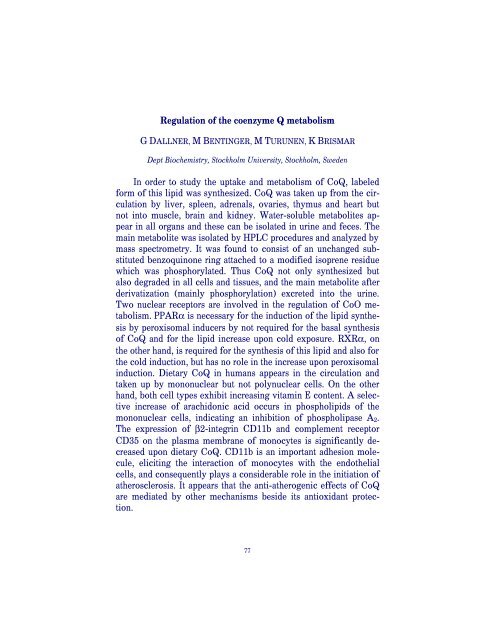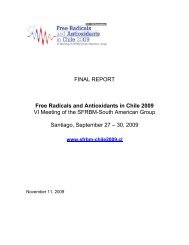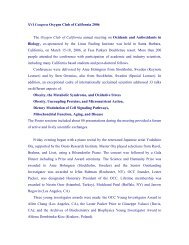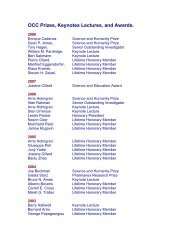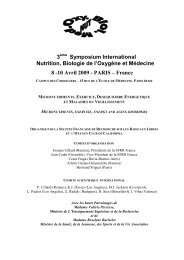oxidants and antioxidants in biology - Oxygen Club of California
oxidants and antioxidants in biology - Oxygen Club of California
oxidants and antioxidants in biology - Oxygen Club of California
Create successful ePaper yourself
Turn your PDF publications into a flip-book with our unique Google optimized e-Paper software.
Regulation <strong>of</strong> the coenzyme Q metabolism<br />
G DALLNER, M BENTINGER, M TURUNEN, K BRISMAR<br />
Dept Biochemistry, Stockholm University, Stockholm, Sweden<br />
In order to study the uptake <strong>and</strong> metabolism <strong>of</strong> CoQ, labeled<br />
form <strong>of</strong> this lipid was synthesized. CoQ was taken up from the circulation<br />
by liver, spleen, adrenals, ovaries, thymus <strong>and</strong> heart but<br />
not <strong>in</strong>to muscle, bra<strong>in</strong> <strong>and</strong> kidney. Water-soluble metabolites appear<br />
<strong>in</strong> all organs <strong>and</strong> these can be isolated <strong>in</strong> ur<strong>in</strong>e <strong>and</strong> feces. The<br />
ma<strong>in</strong> metabolite was isolated by HPLC procedures <strong>and</strong> analyzed by<br />
mass spectrometry. It was found to consist <strong>of</strong> an unchanged substituted<br />
benzoqu<strong>in</strong>one r<strong>in</strong>g attached to a modified isoprene residue<br />
which was phosphorylated. Thus CoQ not only synthesized but<br />
also degraded <strong>in</strong> all cells <strong>and</strong> tissues, <strong>and</strong> the ma<strong>in</strong> metabolite after<br />
derivatization (ma<strong>in</strong>ly phosphorylation) excreted <strong>in</strong>to the ur<strong>in</strong>e.<br />
Two nuclear receptors are <strong>in</strong>volved <strong>in</strong> the regulation <strong>of</strong> CoO metabolism.<br />
PPARα is necessary for the <strong>in</strong>duction <strong>of</strong> the lipid synthesis<br />
by peroxisomal <strong>in</strong>ducers by not required for the basal synthesis<br />
<strong>of</strong> CoQ <strong>and</strong> for the lipid <strong>in</strong>crease upon cold exposure. RXRα, on<br />
the other h<strong>and</strong>, is required for the synthesis <strong>of</strong> this lipid <strong>and</strong> also for<br />
the cold <strong>in</strong>duction, but has no role <strong>in</strong> the <strong>in</strong>crease upon peroxisomal<br />
<strong>in</strong>duction. Dietary CoQ <strong>in</strong> humans appears <strong>in</strong> the circulation <strong>and</strong><br />
taken up by mononuclear but not polynuclear cells. On the other<br />
h<strong>and</strong>, both cell types exhibit <strong>in</strong>creas<strong>in</strong>g vitam<strong>in</strong> E content. A selective<br />
<strong>in</strong>crease <strong>of</strong> arachidonic acid occurs <strong>in</strong> phospholipids <strong>of</strong> the<br />
mononuclear cells, <strong>in</strong>dicat<strong>in</strong>g an <strong>in</strong>hibition <strong>of</strong> phospholipase A 2 .<br />
The expression <strong>of</strong> β2-<strong>in</strong>tegr<strong>in</strong> CD11b <strong>and</strong> complement receptor<br />
CD35 on the plasma membrane <strong>of</strong> monocytes is significantly decreased<br />
upon dietary CoQ. CD11b is an important adhesion molecule,<br />
elicit<strong>in</strong>g the <strong>in</strong>teraction <strong>of</strong> monocytes with the endothelial<br />
cells, <strong>and</strong> consequently plays a considerable role <strong>in</strong> the <strong>in</strong>itiation <strong>of</strong><br />
atherosclerosis. It appears that the anti-atherogenic effects <strong>of</strong> CoQ<br />
are mediated by other mechanisms beside its antioxidant protection.<br />
77


